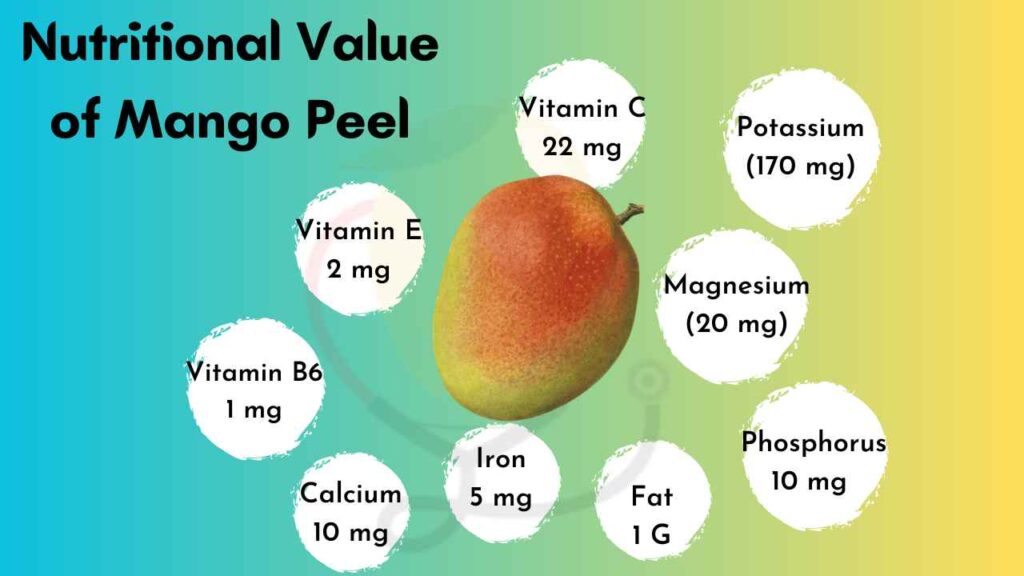Mangoes are one of the most popular fruits in the world. Fruit is a delicious and nutritious way to add flavor to your meals.
When it comes to mango skin, is it safe to eat? The answer is yes. The body needs nutrients and minerals to maintain its natural function.
We’re going to take a close look at the question, “Is mango skin edible?”, and explore the pros and cons of eating it.
The mango skin has a lot of vitamins and plant compounds. People who eat a diet rich in these vitamins have a lower risk of various diseases. It has been shown that mango skin extract has better anti-aging properties than mango flesh extract. The skin of mango is rich in triterpenes and triterpenoids [1], [2], [3].

Nutritional Value of Mango Peel
Mango peel is a rich source of vitamins, minerals, and antioxidants. According to study mango skin contains approximately: [4]

- 65 calories
- 2 grams of protein
- 17 grams of carbohydrates
- 2 grams of fiber
- 5 grams of fat
- 1 grams of saturated fat
- 0 grams of cholesterol
- 5 milligrams of iron
- 10 milligrams of calcium
- 20 milligrams of magnesium
- 10 milligrams of phosphorus
- 170 milligrams of potassium
- 22 milligrams of vitamin C
- 2 milligrams of vitamin E
- 1 milligrams of vitamin B6
Health Benefits of Eating Mango Skin
Eating mango skin may offer some health benefits. For example:

1: Improved digestion
Mango skin contains enzymes that can help break down food and aid digestion. It also contains dietary fiber, which can promote regular bowel movements and reduce the risk of constipation [5].
2: Lowered cholesterol levels
Mango skin contains compounds called mangiferin and catechins, which have been shown to lower cholesterol levels in some studies [6].
3: Boosted immune system
Mango skin is high in vitamin C, an essential nutrient for immune function. It also contains antioxidants that can help protect the body against oxidative stress and inflammation.
4: Reduced risk of cancer
Some studies suggest that mango skin may have anticancer properties [7]. This is because it contains compounds called polyphenols, which have been shown to inhibit the growth of cancer cells in test-tube studies.
Potential Risks of Eating Mango Skin
While mango skin is generally safe to eat, there are some potential risks to be aware of:

Pesticides
Mangoes are often treated with pesticides to prevent insects from damaging the fruit. While the skin may protect the flesh from some pesticide residue, it is still possible to ingest harmful chemicals by eating the skin.
Allergic reactions
Some people may be allergic to mango skin. Symptoms of an allergic reaction can include itching, swelling, hives, and difficulty breathing. If you have a known allergy to mangoes, you should avoid eating the skin.
Tannins
Mango skin contains tannins, which can cause a bitter taste in the mouth and may interfere with the absorption of certain nutrients.
How to Prepare Mango Skin for Eating?
If you decide to eat mango skin, it is important to prepare it properly to minimize the risk of pesticide exposure and other potential issues. Here are some tips:
- Wash the mango thoroughly before eating it. This will help remove any pesticides or other contaminants on the skin.
- Cut the mango into small pieces or slices. This will make it easier to eat and help minimize any bitterness from the tannins.
- Remove any brown spots or blemishes from the skin. These areas may contain more pesticides or other contaminants.
- Try a small piece of the skin first to see how you tolerate it. If you experience any itching or other symptoms, stop eating the skin and consult with a medical professional.
Alternative Uses for Mango Skin
If you’re not sure about eating mango Peel, there are still plenty of recipes to make use of it:
- Make tea. Mango tea have many health benefits and it is a popular drink in some parts of the world. Simply steep the skin in hot water for several minutes and add honey or other sweeteners as desired.
- Use it in smoothies. Mango skin can add a unique flavor to smoothies and other blended drinks.
- Compost it. Mango skin is rich in nutrients and can be a great addition to your compost pile.
- Use it as a natural dye. Mango skin can be boiled with water to create a natural dye that can be used on fabrics and other materials.
So, is mango skin edible? The answer is yes but with some caveats. Mango peel contains many beneficial nutrients, it can also contain pesticide residue and other potential contaminants. If you choose to eat mango skin, it’s important to wash it thoroughly and prepare it carefully to minimize any risks. However, there are still plenty of alternative uses for mango skin if you’re not comfortable eating it.

